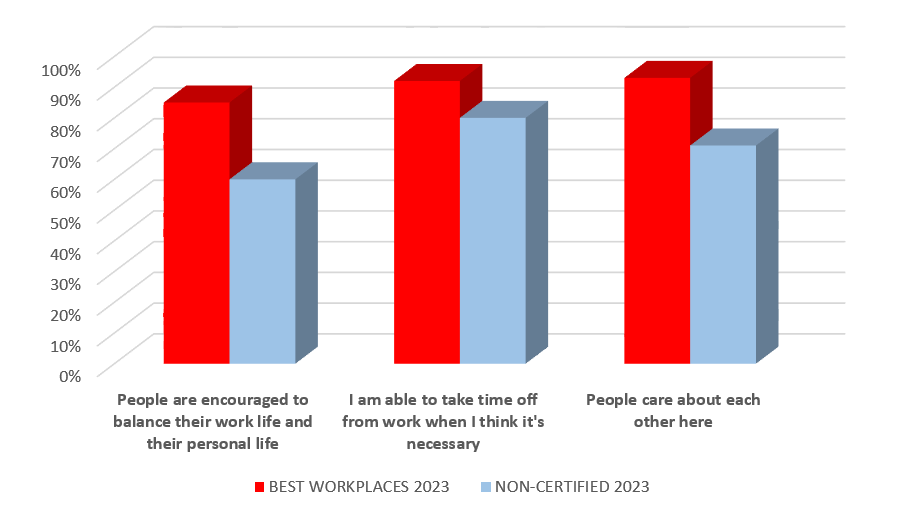In the fast-paced world we live in today, the pursuit of a fulfilling life has become a real challenge. The boundaries between work and personal life have become more fuzzy, leaving individuals struggling to achieve harmony between the two. In this context, the concept of work-life integration has emerged to promote employee well-being and satisfaction. This rather new concept recognizes that individuals are multifaceted and seek to promote a seamless integration of work-related activities with personal responsibilities, values and aspirations.
 The key advantage of work-life integration is the potential for greater flexibility and adaptability. Rather than strictly separating work and personal life, people can use the flexibility offered by integration to better align their work schedules and personal commitments, which gives a sense of autonomy. Research has shown that if people can coordinate their time and responsibilities well, they will also begin to experience greater fulfilment and satisfaction. Since work can be a source of meaning, purpose and personal growth.
The key advantage of work-life integration is the potential for greater flexibility and adaptability. Rather than strictly separating work and personal life, people can use the flexibility offered by integration to better align their work schedules and personal commitments, which gives a sense of autonomy. Research has shown that if people can coordinate their time and responsibilities well, they will also begin to experience greater fulfilment and satisfaction. Since work can be a source of meaning, purpose and personal growth.
However, this integration also comes with a downside: boundary violations. With the ability to work anytime, anywhere, people may find that they are constantly connected to work, even during hours when they are not normally working. This encourages an "always-on" culture, where constant availability and responsiveness are expected and rewarded. It causes people to feel pressured, leading to high levels of stress, workaholism and a reduced sense of work-life balance.
The main question therefore is:
How can we set those boundaries? How can we de-connect to re-connect?
Research has shown that taking a break can do wonders. It increases productivity, reduces stress and improves overall mental health. Plus, we also see that people's creativity can be boosted. Lin-Manuel Miranda, for example, came up with the idea for his successful musical "Hamilton", while on vacation. And high-level athletes performed even better at peak-levels after some rest. Going on a vacation often allows us to come back with a renewed focus, feeling recharged and refreshed.
But taking a break and be able to fully disconnect is easier said than done…
The (perhaps misconceived) expectation to stay connected, to respond to emails, or even to attend meetings in order to keep business running, makes it very difficult to disconnect. And yet research has shown that taking vacations  — as in, completely disconnecting from work — is critical to lower burnout, increase energy and engagement, and to improve overall health and well-being. Which eventually leads to higher productivity.
— as in, completely disconnecting from work — is critical to lower burnout, increase energy and engagement, and to improve overall health and well-being. Which eventually leads to higher productivity.
To counter the "always-on" culture, the Belgian government (along with other countries) has therefore enlisted a legislation since 2022: the right to disconnect from work-related communications and responsibilities outside of regular working hours. A significant step in fostering employee wellbeing. But the government is not the only institute that needs to take action. Whether you are an employee or employer; YOU have impact yourself!
As an employee what can you do?
Here are 5 tips that will help you to deconnect:
- Unplug - Leave your electronic devices at home when going on a trip. Use your daily screen time to read a good book in the sun, to play games with family or friends, to make sudokus or crossword puzzles, to craft some cool things or to go for nice walks. Studies have shown that ‘down-time’ makes us feel more connected to the people around us and that it stimulates our creativity.
- Not possible? - Don’t get caught in the term called “screen guilt”. Sometimes it is not possible to fully unplug and leave devices untouched. But use your screen time wisely. Doomscrolling on social media won’t give your brain and body the rest it needs. Instead, use apps to connect with others, to support you in your physical movement, to get inspiration for fun activities or to challenge your brain through mind games.
- Plan - Be aware of how you want to spend your time. Think about fun activities you can do during a break, weekend or vacation. Research has shown that people who set personal goals during their leisure time – like learning new skills, seeing people or doing a hobby – report being happier with their lives. It helps us to recharge and to get the most out of our time. But there's a small side note: don't think of your goals as a to-do list, as this can actually cause you to lose the enjoyment of pursuing them and it may start to feel like work.
- Move, preferably outdoors - Surprisingly, passive "rest and relaxation" proves not to be so effective when it comes to recovering from the day-to-day rush. Try to be active. Studies have proven that regular movement during breaks – even if it is just a 2 minute walk – improves energy levels, productivity and enhances creativity. And especially if you walk or exercise outside in nature, this has significant benefits for your mental and physical health.
- Change scenery - You don't always have to go far to enjoy yourself, but small changes in environment can do wonders. It literally allows you to disconnect from your daily life. Whether it is on an island in the Caribbean Sea or 10 minutes from your home in a park.
As an employer what can you do?
Amongst others, we see that our Certified Best Workplaces of 2023 score 25% higher than the non-certified companies in fostering a healthy work-life integration for their employees. Which indicates that the best employers understand the importance of disconnecting. And often implement effective policies, practices, and initiatives that support their employees in achieving a healthy equilibrium between their professional and personal lives.

Here are some strategies from our Great Place To Work companies that you can consider implementing as well:
- Establish clear policies and provide flexible working arrangements (if the nature of the work allows this) - Develop and communicate policies regarding after-work availability and the use of digital communication tools outside of working hours. Clear policies help set boundaries and provide clarity to employees. And offer flexible work arrangements, such as remote working, flextime, shortened work weeks or part-time schedules. These can enable employees to manage their work in a way that suits their private needs and responsibilities.
- Provide training and education - Offer training programs or workshops that raise awareness about the importance of work-life integration, stress management, and time management. Educate employees about the potential negative consequences of constant connectivity and provide strategies for setting boundaries and achieving a healthy work-life integration.
- Evaluate workload and resources - Employers should regularly assess and manage employee workloads to ensure they are reasonable and manageable within regular working hours. Adequate staffing levels, task prioritization, and effective delegation can help prevent excessive work demands and minimize the need for employees to work outside of their designated hours.
- Foster a supportive culture and encourage time off - Encourage your employees to make use of their vacation days and other time off benefits. Promote the importance of breaks and relaxation. And make sure that you create a supportive work environment that prioritizes employee well-being. Recognize and reward employees who maintain a healthy work-life integration. Encourage peer support and collaboration to ensure that employees feel supported in managing their work and personal responsibilities.
- And last, but not least: lead by example - Demonstrate and encourage a healthy work-life integration as a leader. By modeling behaviors such as disconnecting from work during non-working hours, taking regular breaks, sending emails during regular working hours and respecting personal time, leaders can set a positive tone and create a culture that values work-life balance.
By implementing these strategies, employers can foster an environment that supports disconnecting from work and promotes a healthy work-life balance, leading to increased employee well-being, satisfaction, and productivity.

-------------------------------------------
SOURCES
Lyons, M. (2023). Set These 5 Boundaries Before You Go on Vacation. Harvard Business Review.
Gruman, J. (2022). The Future of Work - Why is 'the right to disconnect' so important for employees? World Economic Forum.
Fallon-O’Leary, D. (2021). Work-Life Integration Is the New Work-Life Balance. Is Your Team Ready? US Chamber of Commerce.
Samuel, A. (2021). Taking a Break Doesn’t Always Mean Unplugging. Harvard Business Review.
Giurge, L.M., & Bohns, V. (2021) Be Intentional About How You Spend Your Time Off. Harvard Business Review.
Zucker, R. (2020). Thinking of Skipping Vacation? Harvard Business Review.
Giurge, L.M., & Woolley, K. (2020). Don’t Work on Vacation. Seriously. Harvard Business Review.
Denis, K. (2017). Emailing While You’re on Vacation Is a Quick Way to Ruin Company Culture. Harvard Business Review.
Kossek, E. E., Gettings, P., & Misra, K. (2021). The Future of Flexibility at Work. You can tailor programs and policies to fit your employees’ needs. Harvard Business Review.

